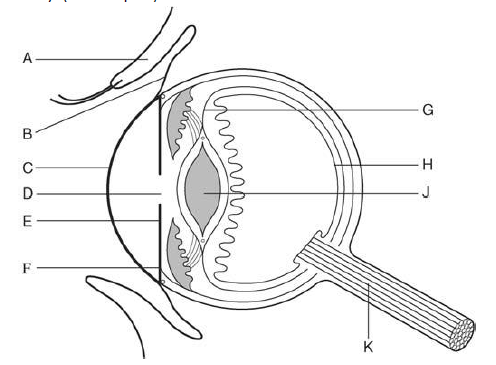
(The eye: a sectional view. A, indicates the eyelid; B, conjunctiva; C, cornea; D, pupil; E, iris; F, ligament of
the iris; G, ligament of the lens; H, retina; J, lens; K, optic nerve. Next to the retina (H) comes the hyaloid
membrane, then the choroid coat and (the outermost) the sclerotic coat)
They constitute the visual system of the body. They are complex sense organs that are basically an extension of the brain. Each eye has a layer of receptors, a lens system for focusing an image on these receptors, and a system of axons for transmitting action potentials to the brain.
i)The eyelids contain a muscular layer that is instrumental in opening and shutting the eyes. Internally they contain a delicate mucus membrane (conjunctiva) which rubs over the surface of the eyeball and tends to remove any dust, particles of debris etc that may collect on the moist surface.
ii)The sclera is the white outer protective layer encasing most of the eyeball. The white appearance is due to the dense white fibrous tissue. The sclera is modified anteriorly into a clear stratified squamous epithelial layer called cornea.
The cornea is the transparent oval in the centre of the white, through which the rays of light pass on their way to the inner parts of the eye.
As light enters the eye it enters a compartment called the anterior chamber. The anterior chamber and posterior chamber are filled with a clear watery fluid called aqueous humor. Separating the anterior and posterior chambers is a diaphragm called iris.
iii)The iris is a pigmented structure containing dilator and constrictor smooth muscle fibers arranged to vary the diameter of the pupil.
The pupil is the hole in the iris through which light passes on its way to the retina.
iv)The lens is suspended in the eye by the suspensory ligaments. The ligaments attach the lens to the ciliary body, a muscular structure at the base of the iris. Behind the lens is a chamber filled with gelatinous fluid called vitreous humor.
v)The retina is also called the nervous coat. It is the innermost coat of the eyeball and it contains photoreceptor cells and nerve cells.
vi)The choroid consists of network of blood vessels which nourish the interior of the eyeball. Choroids is also called vascular coat.
marto answered the question on
April 16, 2019 at 07:46